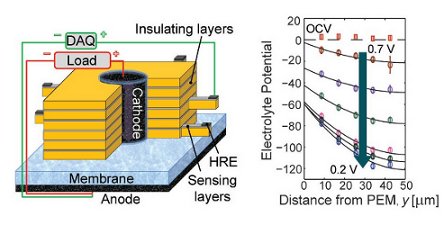Hess et al. Publish on First In-Situ, Through-Plane Measurements in Fuel Cell Electrodes


On 31 October 2011, Analytical Chemistry accepted and pre-published a work by TPES lab members Kacy Hess, Billy Epting, and Prof. Shawn Litster regarding their micro-structured electrode scaffold (MES) through-plane electrode diagnostics. The paper, titled "Spatially-resolved, in situ potential measurements through porous electrodes as applied to fuel cells," describes the lab's unique approach to sensing the ionic potential at discrete points through the cathode catalyst layer of a polymer electrolyte fuel cell (PEFC).
PEFCs still face technological hurdles before widespread commercialization, due in part to their need for platinum catalyst. The platinum-laced electrode is the most costly component of the entire fuel cell system. Present loadings of platinum aren't used very effectively (with as little as 10% effectiveness) due to transport hindrances in the electrode that are not entirely understood.
The unique findings in the paper include the direct measurements of the shifting location of the oxygen reduction reaction in the catalyst layer as the PEFC operating condition in changed from wet to dry conditions. In addition, the work has identified the in-situ ionic conductivity of the electrode is much higher than anticipated.
The paper can be found on pp. 9492-9498, issue 24, volume 83 (2011). It is available on Analytical Chemistry's website, under DOI 10.1021/ac202231y.